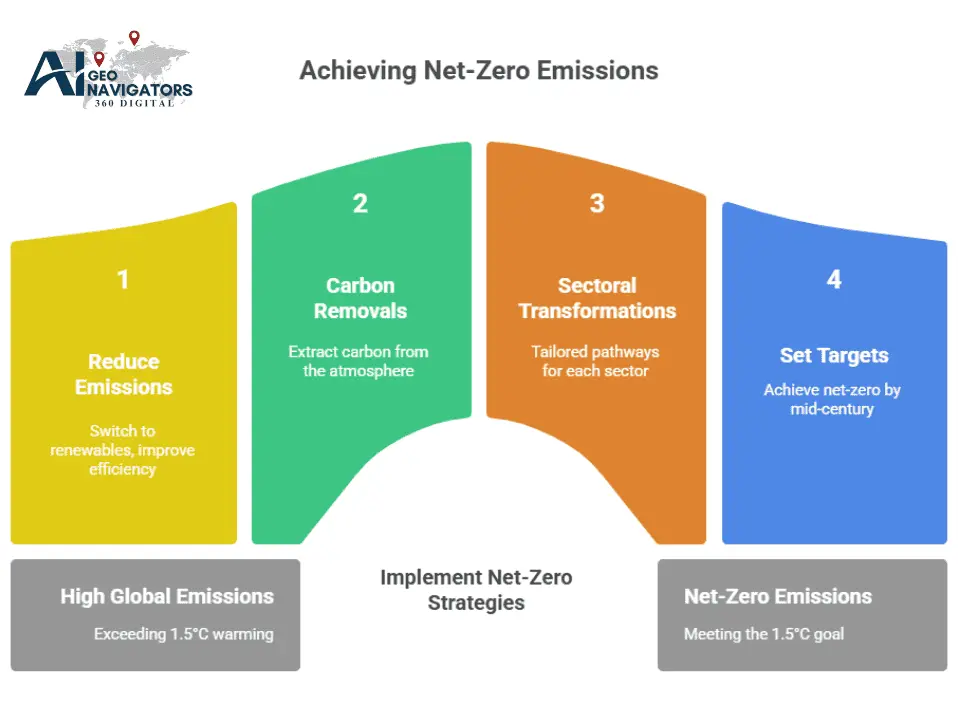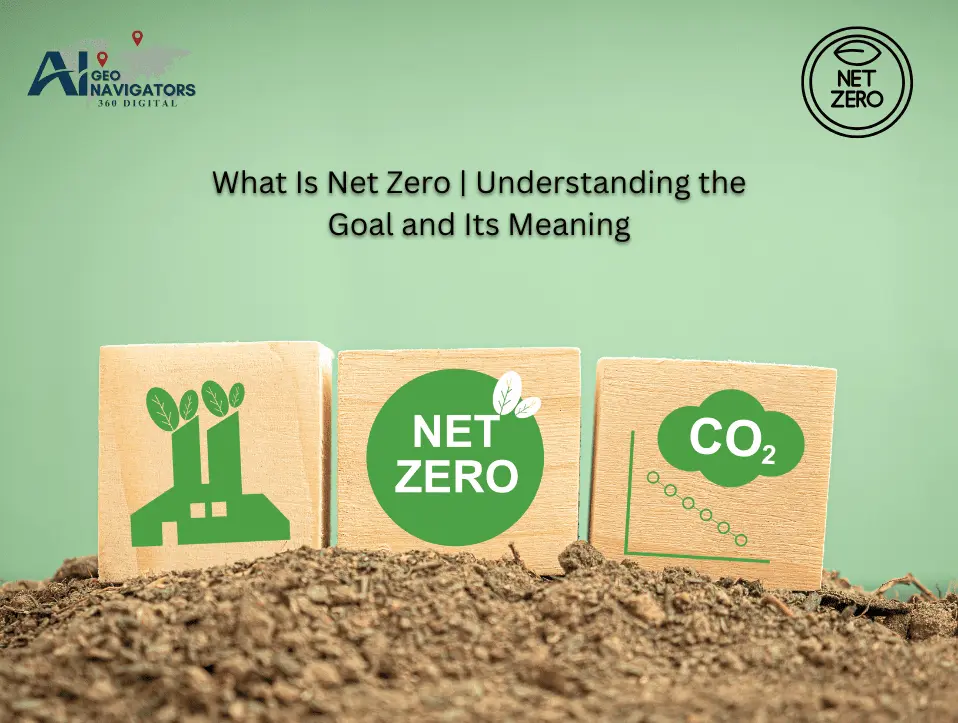Understanding the Goal, Its Meaning, and How to Get There
In recent years, the term net zero has moved from niche climate-policy circles into boardrooms, strategy sessions and everyday conversation. But what does it really mean? And why is it so important for governments, businesses and individuals alike?
At its core, net zero refers to a state in which the greenhouse gas emissions released into the atmosphere are balanced by the amount removed, meaning that human activities no longer increase the total concentration of heat-trapping gases.
In simple language: you still may emit carbon dioxide (CO₂), methane (CH₄) or other greenhouse gases (GHGs), but you also remove or offset an equivalent amount, so the net additional warming effect is zero.
This concept is central to global efforts to limit climate change. According to the Intergovernmental Panel on Climate Change (IPCC) and other climate science bodies, humanity must reach net-zero CO₂/greenhouse gas emissions in the second half of this century to limit global warming to 1.5-2 °C above pre-industrial levels.
Below we explore: the detailed definition, why it matters, how sectors can achieve it, challenges and opportunities, and what net-zero means for businesses and regions.
Key Takeaways
- Net zero means balancing emissions with removals (emissions = removals).
- It applies across scopes, gases and sectors.
- Achieving it helps stabilise global warming and unlocks economic growth.
- It involves emission reduction + removals + systems change.
- Credibility, transparency and science-based targets matter.
- Risk and opportunity go hand-in-hand: transition costs, stranded assets vs green growth and innovation.
- You can begin today: measure, target, reduce, remove, report, iterate.
What Net-Zero Really Means
According to multiple authoritative sources, net-zero means that for a given system (country, company or activity) the total greenhouse gas emissions produced are equal to the greenhouse gases removed or offset.
From the ISO (International Organization for Standardization): “Net zero is often referred to a state in which any human-produced carbon dioxide or other planet-warming gases can be removed from the atmosphere.”
In other words, you either reduce your emissions or you remove or offset them — or both — until the net-addition to the atmosphere is zero.
This is different from zero emissions (which would mean no emissions at all), or simply carbon neutral (which sometimes only deals with CO₂ and not all GHGs).
Who Defines Net-Zero?
Governments, businesses, and organizations often define their net-zero targets in different ways, sometimes including scope 1, 2 and 3 emissions (direct, energy-indirect, and value-chain emissions). Standards such as the Science Based Targets initiative (SBTi) help define what is required to claim credible net-zero.
It’s important to note that the term “net zero” can be applied globally (the whole planet), nationally (a country), or corporately (a company or organisation).
Why Net-Zero Matters
Climate Science Imperative
The science is clear: continuing to emit greenhouse gases at historical rates will lead to worsening climate change more extreme heat, sea-level rise, changing rainfall patterns and increased risk of ecosystem breakdown. Reaching net-zero is the pathway to stabilizing global temperatures.
By balancing emissions and removals, we halt the net addition of heat-trapping gases to the atmosphere — which in turn means that warming eventually plateaus.
Business and Economic Relevance
For companies and organisations, setting a net-zero target is no longer just a sustainability checkbox — it’s strategic. Investors, customers, regulators and employees increasingly expect clarity on how an organisation will operate in a low-carbon economy. The transition to net-zero opens new markets (e.g., renewables, energy efficiency, carbon-capture technologies) while avoiding the risks associated with future-stranded assets and regulatory shifts.
Social and Environmental Co-Benefits
Beyond climate goals, net-zero strategies often bring additional benefits: improved air quality, healthier communities, increased energy-efficiency, more sustainable supply chains, and greater resilience to climate shocks. Thus, net-zero is not just about subtracting emissions; it is about transforming how we build, consume and live.
Policy and Global Targets
Many nations have committed to net-zero targets by mid-century (e.g., 2050). These commitments align with frameworks like the Paris Agreement. The international push toward net-zero means that policies, carbon pricing, clean energy incentives, and technology deployment will continue to intensify.
Pathways to Achieve Net-Zero

Emissions Reduction Strategies
The first and most critical step: reduce emissions as far as possible. This includes switching from fossil fuels to renewables, improving energy-efficiency, electrification of transport, low-carbon materials, circular economy practices and more.
Carbon Removals and Offsets
Given that some emissions are very hard to eliminate (e.g., industrial processes, aviation, heavy manufacturing), achieving net-zero will also require removals — i.e., technologies or nature-based solutions that extract carbon from the atmosphere and store it. These include afforestation, carbon capture & storage (CCS), direct air capture (DAC), bioenergy with carbon capture & storage (BECCS) and more.
Sectoral Transformations
Different economic sectors require tailored pathways:
- Power & electricity: shift to renewables, clean grids, storage
- Transport & mobility: electric vehicles, shared mobility, sustainable fuels
- Industry & manufacturing: low-carbon materials, process innovation, CCS
- Buildings: energy-efficient design, heat-pumps, smart systems
- Agriculture & land-use: sustainable farming, soil carbon storage, afforestation
These interactions and dependencies mean the net-zero transition is complex and interconnected.
Timing and Targets
To meet the 1.5 °C goal, global scientists estimate that emissions must fall sharply by 2030 and reach net-zero around mid-century (2050) for many economies.
The Role of Innovation and Finance
Large-scale deployment of clean technologies, energy-storage, low-carbon fuels and digital systems will require major investment and innovation. Experts estimate that trillions of dollars will be needed globally to support the transition.
Net-Zero for Businesses and Organizations
Setting a Net-Zero Strategy
Organisations that want to align with net-zero should:
- Measure their full greenhouse-gas footprint (Scopes 1, 2 & 3)
- Set a clear target date for net-zero (e.g., 2040, 2050)
- Develop a plan for deep reductions (often ~90% or more)
- For remaining emissions, define credible carbon-removal or offset solutions
- Report transparently on progress, governance and performance
Corporate guidance like the SBTi’s “Corporate Net-Zero Standard” provides frameworks for this.
Avoiding Greenwash
Because net zero is so widely used, organisations must ensure credibility. Using vague offsets without real reductions may be considered greenwashing. Transparent metrics, independent verification, science-based targets and full-value-chain coverage are important.
Opportunities for Business Growth
Companies aligned with net-zero may gain competitive advantages: access to green markets, improved brand reputation, risk mitigation, cost savings from efficiency, and better alignment with investor expectations.
Risks and Considerations
Pursuing net-zero involves risks: possible stranded assets, regulatory changes, supply-chain disruption, and technology uncertainties (especially in hard-to-decarbonise sectors). Businesses need resilient strategies that accommodate uncertainty.
What Comes Next?
Technological Innovation
We’ll see greater deployment of advanced technologies: energy storage, hydrogen, electrification, carbon-capture, circular economy processes. The next decade is pivotal.
Systems Change
Achieving net-zero is not only individual projects but systems transformation: how cities are built, how industries operate, how we travel, how we eat. The transition will be cross-sectoral and interconnected.
Rising Expectations and Accountability
As net-zero becomes mainstream, stakeholders will demand higher transparency, integrity, and proof of action. This increases the value of rigorous reporting, independent verification and full emission-scope disclosure.
Business Growth and Green Economy
Net-zero isn’t just a cost but an opportunity. New markets will emerge, green jobs will grow, clean technologies will scale and companies that lead the transition stand to gain competitive advantage.
Conclusion
In summary, net zero is a pivotal concept in the fight against climate change, representing the point at which human-generated greenhouse gas emissions are matched by equivalent removals, so that no additional warming occurs. It is more than a target; it is a transformation of how we produce, consume and live.
For governments, it demands policy, infrastructure and international cooperation. For businesses, it requires deep strategy, science-based targets and credible action. For individuals and communities, it offers a vision of sustainable living, resource efficiency and resilience.
The path to net-zero is challenging, complex and urgent. But it is also full of possibility. New technologies, new business models and new mindsets are emerging. If we act boldly, early and together, we can reshape our economy and environment for a thriving future.
Whether you’re a company seeking net-zero operations, a city planning green infrastructure or an individual rethinking your carbon footprint, the journey begins now. Because the longer we delay, the more we pay.
Let’s embrace the net-zero future, not just as a goal on paper, but as a reality in action.
By understanding and engaging with net-zero, we can transform our world rather than simply sustain it building a future where growth, innovation and climate resilience go hand in hand.


No responses yet